
views
Gathering Your Materials
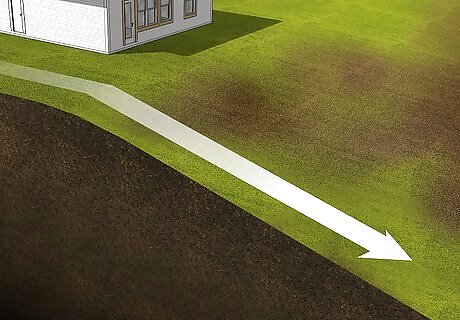
Find a location with a steep slope affected by erosion. These benefit the most from retaining walls. Signs of soil erosion include exposed roots, patches of dead land, landscape changes (more bugs or worms, more rocks, soil that is suddenly denser and harder), and clumps of grass floating in nearby water. Just avoid locations where water tends to ooze up or stand—these are not good choices as the water will rot your wall and ruin it rather quickly. Select a location where the excavated soil will be roughly equal to the backfill material needed behind the wall.
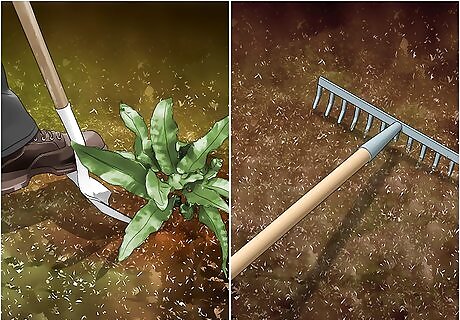
Clear and rake the area where you want to build your wall. Start by removing any garbage and rocks. Afterward, remove any plants by digging in a circle around the roots, taking care to cut through as many as possible. Once you've cut them, jam the shovel underneath the plant's roots and lever it up and out of the ground. After the area is clear, rake it smooth. Continue raking the soil until it's level. Destroy as many roots as you can to prevent them from regrowing.

Purchase your wood pieces from a home hardware store. Determine how many 4 by 4 inch (10 cm × 10 cm) posts—spaced 3 feet (0.91 m) apart—you need for your retaining wall and purchase them from a local home hardware store. Afterward, purchase 2 by 6 inch (5.1 cm × 15.2 cm) boards to extend between your posts. Either have the staff cut your wood to size or purchase larger pieces to cut them to size on your own. Give yourself an additional 18 inches (46 cm) on top of your post height to go in the ground. If your retaining wall is going to be 40 feet (12 m) long, you need 14 posts—40 (length of the wall) divided by 3 (space between each post)—for your wall. If it's going to be 5 feet (1.5 m) tall, make sure your posts are 5 feet (1.5 m) tall with an additional 18 inches (46 cm) on top. In the previous example, if your wall is 5 feet (1.5 m) tall, you need to stack 10 pieces of 2 by 6 inch (5.1 cm × 15.2 cm) boards vertically—5 feet (1.5 m) divided by 6 inches (15 cm)—to create the height of the wall. Ask the staff to cut you 10 pieces 3 feet (0.91 m) long for every 2 posts.
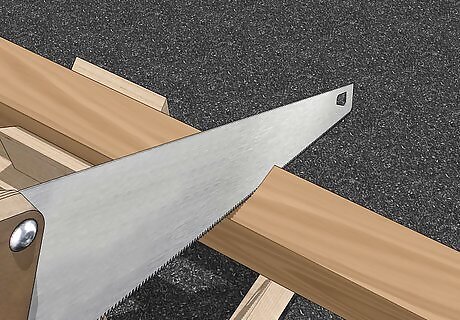
Cut your wood posts to length if they aren't already. If you didn’t get your wood pieces cut at the home hardware store, cut your posts to the size with a circular saw. Hold each piece of wood still with your non-dominant hand and guide the saw forward with your dominant hand. Apply downward pressure to each wood piece as you cut to keep it steady. After you're done, set your posts aside for later. Let the shortest piece of your wood hang to prevent jamming.
Digging Your Holes
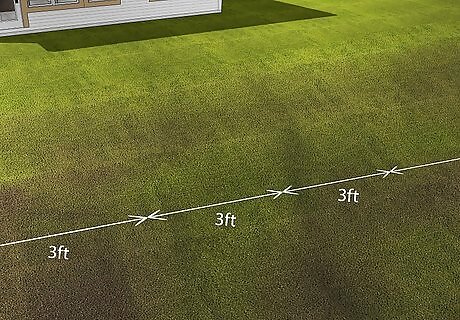
Mark your post hole locations on the ground with chalk. Each post should be 3 feet (0.91 m) away from each other—start by marking the first post location with chalk at one end of the wall. Now, move in 3 foot (0.91 m) increments along the line until you reach the end. Use a taut string and stakes or a snapped chalk line to help you create a straight line. If you need to extend your wall with another post to create the final 3 feet (0.91 m) then do so. Space your posts 16 to 18 inches (41 to 46 cm) apart for load-bearing walls, which are walls that support something aside from their own weight such as a roof.
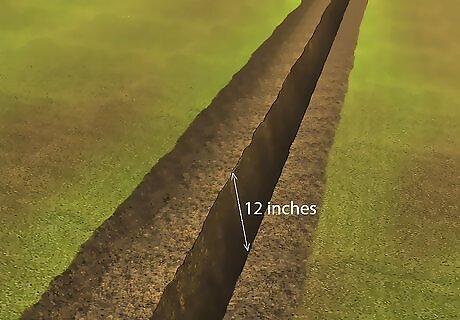
Dig a 12 inch (30 cm) deep trench between your post locations. Start by using a D-handle shovel to loosen the dirt along each side of the trench. Once it's loose enough, dig out the middle with a trench shovel. Continue loosening and digging into the soil with each of your shovels. Call your local utility services number at least 3 to 4 days before digging to ensure it's legal and won't damage underground structures, such as power, sewer, water, or gas lines. Consider renting heavy equipment to dig your trench. Saw through large roots with a reciprocating saw or using the tip of your trench shovel. Use a steel bar to loosen rocks.
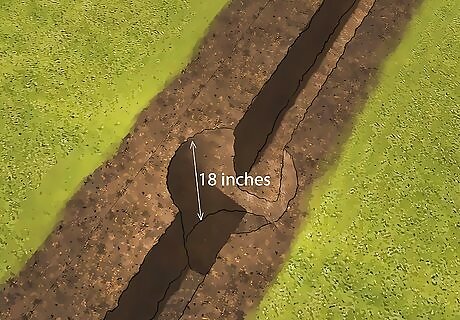
Dig 18 inch (46 cm) deep holes for your posts. Thrust your shovel into the soil and jiggle it forward and backward and side to side. Once the soil is loosened, start digging down into the ground. Grip the middle of the shovel's handle with your non-dominant hand and the top of the handle with your dominant hand. Use a steel bar to knock rocks loose. Remove large sections of loose soil with a clamshell digger. Saw through large roots by thrusting your shovel down into them or using a reciprocating saw.
Installing Your Posts and Wall
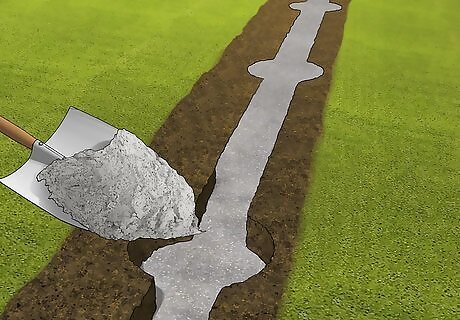
Fill the holes with cement and then level them. Mix your cement and water in a wheelbarrow while following manufacturer's directions. Afterward, gently tilt the wheelbarrow forward and pour the cement into the holes. Use a hand float the level the surface of the cement with the ground when you're done.

Insert the posts into the holes immediately. After inserting the posts into the holes, press them down to make sure that their bottoms are flat against the bottom of the hole. Do this as quickly as possible and make sure that they're perfectly vertical. If you have to, hold them in place with your hands until they settle into a vertical position. Make sure that they remain in place after letting them go. You can also place 2 by 4 inch (5.1 cm × 10.2 cm) boards on either side of the posts to hold them in place.
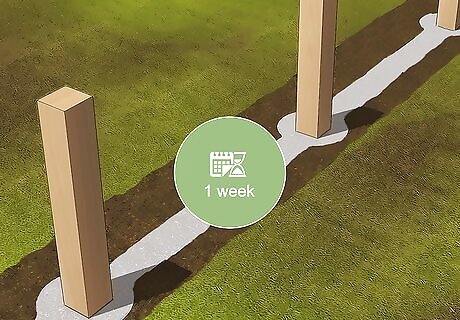
Allow the concrete to dry for 1 week. Once your posts are securely settled into the concrete, give the concrete time to cure. By waiting for a week, you're ensuring that the posts will be sturdy enough to support the weight of the rest of the fence. Read the directions on the package of concrete mix for specific curing instructions, as these can vary between brands.
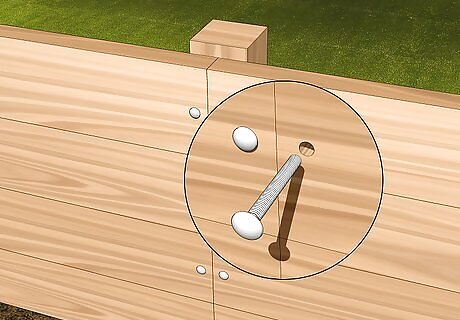
Connect your 2 in × 6 in (5.1 cm × 15.2 cm) boards between your posts. Use carriage bolts and an electric drill to connect your boards to the outside of your posts. Take care to ensure that the leftmost and rightmost part of each board aligns with the vertical center line of each post they connect to. If your boards are shorter than the length between your posts, cut them so that they sit in the middle of each post. Place 16 penny nails or deck screws between each deck board to space them enough for expansion.
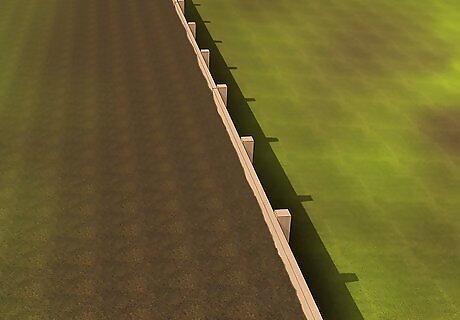
Fill the area behind your boards with soil until it reaches the top of the boards. Use the soil you removed from the trench to fill the area behind the boards. If you need more, purchase some from a home and garden store. Be sure to pack the soil down firmly when you're done. If you need to purchase additional soil, make sure it's a similar composition as the soil from your trench.




















Comments
0 comment